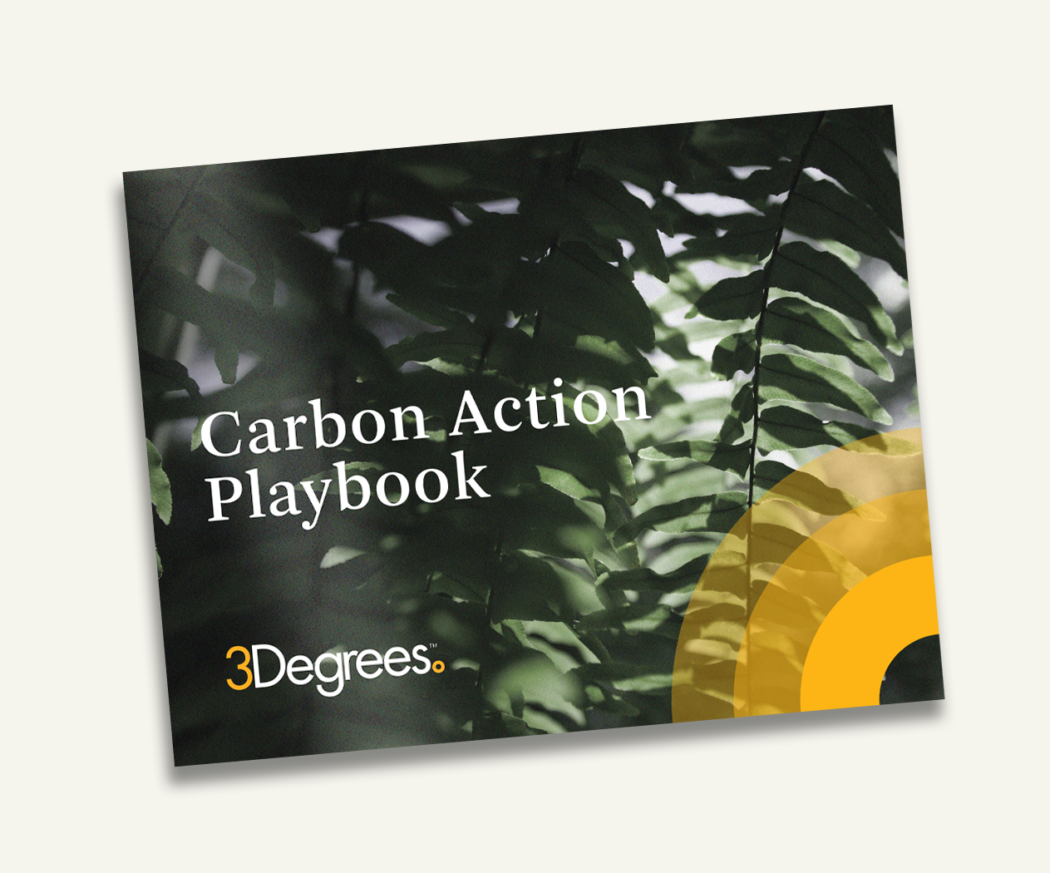Carbon
Carbon Credits

Carbon reduction and removal projects you can trust
Meeting the demands of accelerating climate change requires a swift and meaningful decarbonization strategy. At 3Degrees, we ensure that your carbon credit purchase is not simply transactional, but a strategic move towards supporting credible emission reduction and removal projects. By investing in trusted carbon projects, your organization can create an immediate impact, drive demand and financing for carbon reduction and removal innovation, and extend global climate mitigation beyond your value chain.
Together, we can make a meaningful impact against climate change.
Your expert carbon partner
Let 3Degrees support you through the complete carbon credit purchasing process to maximize impact and mitigate risk.
Carbon Strategy
- Create short and long-term carbon strategy
- Determine which types of credits to buy
- Assess long-term carbon credit procurement scenarios
Carbon credit transactions
- Curate a portfolio of independently-verified credits from high-quality projects that map to your goals and purchasing criteria.
- Lead the monitoring, reporting, and verification for managed projects
- Conduct extensive due diligence for partner projects
Supply chain carbon reductions
- Explore value chain decarbonization opportunities
- Procure carbon insets or carbon credits within your value chain
- Develop new carbon projects within your value chain
Download the Carbon Action Playbook
Learn how to shape your climate strategy, and discover the pivotal role carbon credits play in achieving global sustainability goals.

Setting the bar for carbon project due diligence

- Experienced in-house project operations team directly manages project verification, as well as the creation and issuance of many of the credits we bring to market.

- Seasoned technical team selects projects that meet our high environmental integrity standards over the life of the project.
- All of the credits we sell comply with the ICROA Code of Best Practice, are from one of the five ICROA-endorsed voluntary carbon offset registries, and adhere to an existing protocol or methodology.

- Project-level details (owner, start date, developer, history, etc.)
- Baseline calculations and accounting precision
- Rigor of methodology/protocol
- Additionality
- Community engagement & social justice
- Assessment of project leakage & positive/negative non-greenhouse gas (GHG) environmental & social impacts
- Co-certifications
- And more
Carbon credit clients




“Our carbon neutral shipping initiative is a major milestone within our larger commitment to act urgently and aggressively in the fight against climate change. We are excited to partner with 3Degrees in order to support projects with a high level of environmental integrity that will evolve with our growing needs.”
The 3Degrees difference
Serious about due diligence
We apply our monitoring, reporting, and verification (MRV) expertise to our extensive pipeline of managed projects and conduct a due diligence process on our portfolio of partner projects.
Specialists in risk-mitigation
We help our clients build carbon portfolios by utilizing our expertise in navigating real-time market changes, emerging environmental regulations, and accurately interpreting guidance from globally recognized standards and reporting bodies.
Builders of custom and diverse solutions
We thoroughly evaluate our clients’ business needs and curate a portfolio from our wide range of options that support their climate targets, generate impactful results, offer additional co-benefits, and resonate meaningfully with their stakeholders.
Technical experts
From conducting meticulous project-level quantification to skillfully crafting effective and accurate environmental claims, our end-to-end specialization ensures our clients’ efforts make a difference while also mitigating risk.
Expertise by the numbers
3Degrees has a long track record of developing projects and executing carbon strategies that deliver tangible, measurable, and lasting positive outcomes.
new U.S. carbon credit projects co-launched since 2004
verified carbon credits delivered
countries from which we source verified emission reductions
methane projects for which we have managed the verification and issuance of carbon credits
registered project to issue California Compliance Offsets
registered carbon project in the RGGI compliance market
Carbon removal and reduction projects
Explore a sample of our robust carbon credit project portfolio.

Conserving a Cold-water Lifeline for Salmon on California’s Redwood Coast.

The BioLite Improved Stove Programme distributes approximately 2,500 domestic fuel-efficient cook stoves to Ugandan households.

This dairy in Florida has installed a digester to cut emissions and build a source of clean energy.

This Washington-based dairy uses a Livestock Water Recycling System to lower methane from livestock waste.

The Flathead Electric Cooperative Landfill Gas-To-Energy Project drastically reduces local greenhouse gas emissions.

Auto parts manufacturer pioneers new process and reduces GHGs – uses carbon credits to change an industry.
Carbon credit FAQs
Browse the FAQs below to find answers to the most common questions we receive on carbon credits.
What are carbon credits (carbon offsets)?
A carbon credit is created when one metric ton (MT) of a greenhouse gas (GHG) is avoided, reduced, or removed. Carbon credits are also known as carbon offsets or verified emissions reductions (VERs). In order to be used as a legitimate carbon mitigation tool, carbon credits must adhere to specific criteria as detailed below.
What makes a good carbon credit project?
At a minimum, high-quality carbon credit projects will be audited by an accredited, third-party verifier and meet specific criteria dictated by internationally recognized standards bodies. These criteria include additionality, detailed quantification of the greenhouse gas reduction or removal activity as compared to a baseline, and permanence. There are many different types of carbon projects that are eligible to generate carbon credits as long as they adhere to the requirements of methodologies that have been approved by the standards bodies. Furthermore, voluntary carbon projects can be found in many countries across the globe.
What is additionality and why do carbon projects need to be “additional”?
- All carbon credit projects must be “additional”, meaning that the activity wouldn’t have occurred in the absence of the carbon market. This is essential because carbon credit buyers shouldn’t be financing activities via carbon credit revenue that would have occurred anyway.
- All projects are required to provide evidence that the emission reductions or removals are not “business as usual”. All projects must quantify a baseline, which is the total quantity of emissions in a specific timeframe that occurred prior to the implementation of the project.
- Additionality can be assessed in different ways, examples from a project-specific approach include:
- Financial – demonstrating that the project activity would not have been possible without carbon finance.
- Regulatory – demonstrating that the project activity is not legally required, or goes beyond any relevant compliance requirements.
- Common practice – demonstrating that the project implements an activity that is not common practice.
- Each internationally-recognized standards body has its own methods for assessing additionality.
Why is conservative quantification of greenhouse gas (GHG) reduction or removals important?
GHG accounting is the quantification of GHG emissions produced by an activity or within a boundary. When applied to carbon credit projects, GHG accounting requires the use of a precise and conservative methodology that has been scientifically reviewed and tested. This includes determining the emissions associated with the project’s baseline, or the activity under the business-as-usual scenario. Once the project has been implemented, the actual amount of emissions reduced or removed over a specific timeframe are quantified and then compared to the baseline scenario. The delta between the two represents the number of carbon credits generated during that reporting period.
What is permanence and how do carbon projects address it?
- Permanence refers to the requirement that a carbon credit represents a metric ton of greenhouse gas emissions reduced or removed that cannot be reversed. Permanence, also referred to as durability, ensures that the greenhouse gasses remain stored for a set amount of time as a result of the project activity.
- Land-use projects face the greatest permanence risk due to the potential for a “reversal.” A reversal occurs when stored greenhouse gasses are released back into the atmosphere, either from unintentional (weather events or natural disasters) or intentional (human-caused disturbances) events.
- The obligation to ensure permanence belongs to the program, project operator and/or landowner. To ensure that a given carbon credit represents a permanent reduction or removal in emissions, projects are required to set aside a designated percentage of credits into a “buffer pool.” The general rule is that reversals are made whole by canceling an equivalent quantity of credits from the buffer pool, which acts as an insurance mechanism managed by each carbon credit registry.
- Each internationally-recognized standards body has its own methods for assessing permanence requirements and reversal risk.
What is meant by carbon project co-benefits?
- Co-benefits are the positive environmental and social impacts that result from a specific carbon project beyond the GHG reduction or removal benefits.
- Examples across various project types include improved air quality near landfill gas projects, habitat protection when improved forest management practices are implemented, or additional jobs for local community members.
What does it mean to be third-party verified?
- Every carbon project is required to undergo periodic verifications, which include an independent ex-post audit that evaluates the quantification of GHG emissions that have been avoided or removed by the project after the activity has taken place.
- Verifications ensure that the project was being monitored appropriately throughout each reporting period, sufficient data was collected to conduct a robust calculation, and the project was not out of compliance with any local, state, or federal regulations.
What role do the various carbon registries and standards bodies play?
- The main internationally-recognized standards bodies are the American Carbon Registry (ACR), Climate Action Reserve (CAR), Gold Standard (GS), and Verra. Each organization maintains a standard that provides guidelines for new and existing carbon projects and approves methodologies for specific project types.
- The standards bodies also act as registries, commonly referred to as tracking systems, enabling project owners to publicly share project documents, issue and transfer credits, and for end-users to retire credits.
- Registries play a critical role in maintaining a credible market and transparently documenting credit issuances and retirements.
What are some examples of different types of carbon credit projects? How do avoided emissions and carbon removal projects differ?
- Some of the most common project types include renewable energy, reducing emissions from deforestation and degradation (REDD), improved forest management, reforestation/afforestation, improved cookstoves, and methane capture or avoidance at landfills and dairy farms.
- Carbon projects, which are either nature-based or technology-based, can address GHG emissions in two ways: by avoiding the release of greenhouse gasses and/or removing carbon from the atmosphere.
- Avoided emissions projects focus on avoiding the release of greenhouse gases into the atmosphere. For example, dairy farms can implement manure management systems that capture methane, which otherwise would have been released into the atmosphere.
- Carbon removal projects pull or sequester carbon from the atmosphere. For example: planting trees and using them as natural carbon sinks that store carbon in their trunks and roots.
What are nature-based solutions?
Otherwise known as natural climate solutions, nature-based solutions refer to the conservation, restoration and/or improved land management practices that increase carbon storage, or avoid greenhouse gas emissions in forests, grasslands, wetlands, or oceans. In addition to the GHG benefits, protecting, restoring, and sustainably managing natural ecosystems helps us adapt to the impact of climate change and provides significant environmental and social co-benefits.
What impact does purchasing carbon credits have?
Purchasing carbon credits can support the development of carbon projects, as well as the ongoing monitoring, reporting, and verification that is required to maintain the project on an ongoing basis. Carbon revenue creates incentives for unregulated, high-carbon emitting industries to implement emission reduction or removal activities that go above and beyond “business as usual” practices.
Why do prices vary across different types of carbon projects?
- There are many reasons for the cost disparity for carbon credits from various projects including size, location, project type, and ongoing monitoring/verification expenses. Some projects that offer significant co-benefits often command a premium in the market, particularly benefits that align with contributions towards Sustainable Development Goals (SDGs).
- Since carbon credits are a market-based mechanism, credit prices are subject to supply and demand fundamentals, meaning the market price will go up when there is more demand and/or less supply.
Why is the validation and verification process so complex?
- The process of project development to credit issuance can take up to two years, if not more, as it requires complex accounting and in-depth verification to uphold the environmental integrity of the greenhouse gas reductions or removals. The groups involved in the process include the standards body, the project developer, and a third-party verifier. Generally, the process follows these steps:
- Project registration and validation – once a project has been developed or implemented, the project developer creates project design documents, which lay out all of the details of the activity and the estimated number of carbon credits the project is expected to generate over the life of the project. The verifier audits these documents and submits them to the standards body. The standards body reviews and approves the project credentials, meaning the project is now eligible to generate carbon credits moving forward. This is usually a one-time activity that occurs at the onset of a project.
- Project verification – Once the project has been implemented and is being accurately monitored for some amount of time (usually between 1-5 years), the project developer quantifies the volume of greenhouse gasses that have been avoided or reduced during that time compared to the baseline. The verifier audits these findings and develops the verification report to be submitted to the registry.
- The registry reviews the verification documents. Once approved, carbon credits are issued.
- Projects continue to undergo periodic verification and can issue credits annually or can issue multiple years of credits at once.
How should carbon credits fit into a company’s overall climate strategy?
Purchasing carbon credits is not a climate strategy on its own. It is critical for companies to first set and pursue both near and long-term science-based emission reduction targets. As a complement to this activity, carbon credits are an immediate tool for organizations to support emission reduction and removals activities that address scope 1 and 3 emissions that cannot be mitigated in the near term. Put another way: carbon credits are a valuable tool in a larger toolbox of an organization’s decarbonization initiatives, but can’t and shouldn’t be the only tool. Carbon projects can play an important role in accelerating the decarbonization of unregulated, high-emitting sectors, as well as the protection and restoration of our natural ecosystems.
Suggested insights

Explore this paper to learn how your organization can develop its own strategy for building a robust carbon removals market that can support net zero ambitions by 2050 or sooner.

Dive into the new decarbonization solution, biochar, to discover if it’s the right investment for your business.

Join 3Degrees on a journey through the heart of sustainable agriculture! In this exclusive behind-the-scenes video, we explore innovative methane reduction practices on two local farms.
Get in touch
Learn more about how 3Degrees can support your organization at any stage of your sustainability journey.
